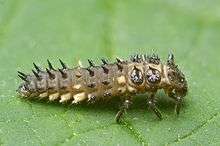Cream-spot ladybird
| Cream-spot ladybird | |
|---|---|
 | |
| Adult insect | |
 | |
| Larva | |
| Scientific classification | |
| Kingdom: | Animalia |
| Phylum: | Arthropoda |
| Class: | Insecta |
| Order: | Coleoptera |
| Family: | Coccinellidae |
| Genus: | Calvia |
| Species: | C. quatuordecimguttata |
| Binomial name | |
| Calvia quatuordecimguttata (Linnaeus, 1758) | |
| Synonyms[1] | |
| |
The cream-spot ladybird, Calvia quatuordecimguttata, is a species of ladybird in the family Coccinellidae. Its distribution is holarctic, it being found in northern Europe, northern Asia and North America. This ladybird is generally 4 to 5 millimetres (0.16 to 0.20 in) in length and varies in appearance depending on the geographical location. It usually lives in hedgerows and deciduous trees.
Taxonomy
This ladybird was first described by Linnaeus in 1758 as Coccinella 14-guttata. As ladybirds were further studied, it was transferred to the genus Calvia which was erected in 1873 by the French entomologist Étienne Mulsant.[2] The specific name comes from quatuordecim, the Latin for "fourteen" and guttata, the Latin for "spotted".[1]
This ladybird is also sometimes known as the cream-spotted ladybird, the polkadot ladybird or the eighteen spot ladybird and may be confused with another beetle also known as the eighteen-spot ladybird (Myrrha octodecimguttata). The latter is usually found on pine trees and is smaller and a paler brown colour and has a characteristic M-shaped white mark on its pronotum.[3]
Description

The cream-spot ladybird measures 4 to 5.5 millimetres (0.16 to 0.22 in) long and 3.2 to 4.5 millimetres (0.13 to 0.18 in) broad. It is very variable in colouration in North America. In Europe the species is consistently is maroon-brown with fourteen cream-coloured spots, but in North America and parts of eastern Asia it occurs in several other colour forms. It may be black with white spots (similar to the European form but darker), or anywhere from yellow to pink with 18 large blotches. An excessively melanistic version exists that is all black with a large red-orange patch on each elytron. It always has a glossy pronotum and the underside of the beetle has a thin red rim to the otherwise black abdominal segments.[1][4]
The larvae are black with white markings, have six legs and several blunt conical spines on each segment of the abdomen, similar to larvae of Cycloneda but with shorter legs.[1]
Distribution
The cream-spot ladybird has a holarctic distribution. In North America the range extends from Alaska and Labrador south to California and New Jersey.[1] It also occurs in northern Europe and Asia but is absent from the most northerly parts.[5] It is present throughout Britain and Ireland though more common in England than further west and north.[6]
Ecology
The cream-spot ladybird is usually found on deciduous trees and bushes where they and their larvae feed on soft-bodied insects such as psyllids and aphids.[4] In a study it was found that their preferred prey aphids included the aspen leaf aphid Chaitophorus tremulae, the angelica aphid Cavariella konoi, the small willow aphid Aphis farinosa, the lime-tree aphid Eucallipterus tiliae, the birch aphid Euceraphis betulae and the mugwort aphid Macrosiphoniella artemisiae.[7] They overwinter in leaf litter, crevices in the bark of trees and other similar protective locations.[4]
References
- 1 2 3 4 5 Kits, Joel (2011). "Species Calvia quatuordecimguttata - Cream-spotted Lady Beetle". BugGuide. Retrieved 2013-01-15.
- ↑ Mulsant (1850). "Species des coléoptères trimères sécuripalpes, p.143" (in French). Retrieved 2013-01-15.
- ↑ Trevor and Dilys Pendleton (2004). "18-spot Ladybird Myrrha octodecimguttata". Eakringbirds.com. Retrieved 2013-01-15.
- 1 2 3 "Cream-spot ladybird (Calvia 14-guttata)". UK Ladybird Survey. Retrieved 2013-01-15.
- ↑ Harde, Severa (2000). Der Kosmos Käferführer, Die mitteleuropäischen Käfer. Franckh-Kosmos Verlags. ISBN 3-440-06959-1.
- ↑ "Interactive map of Cream-spot Ladybird (Calvia quattuordecimguttata)". NBN Gateway. National Biodiversity Network. Retrieved 2013-01-15.
- ↑ Kalushkov P, Hodek I. (2001). "New essential aphid prey for Anatis ocellata and Calvia quatuordecimguttata (Coleoptera: Coccinellidae)". Biocontrol Science and Technology. 11 (1): 35–39. doi:10.1080/09583150020029727.